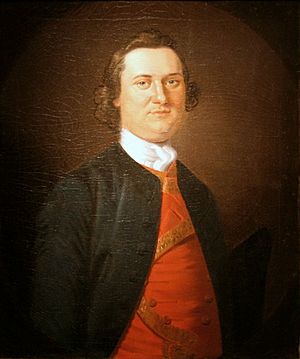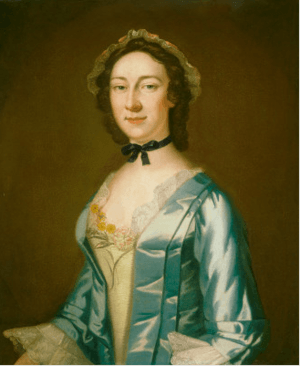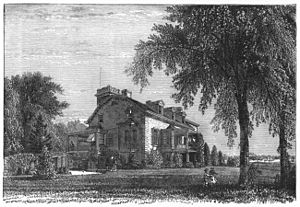Lewis Morris facts for kids
Quick facts for kids
Lewis Morris
|
|
|---|---|

Morris painted by John Wollaston (c. 1750)
|
|
| New York State Senator from the Southern District |
|
| In office July 1, 1783 – June 30, 1790 |
|
| In office September 9, 1777 – July 1, 1781 |
|
| Member of the Continental Congress from New York |
|
| In office 1775-1777 |
|
| Member of the New York Provincial Congress |
|
| In office 1775-1777 |
|
| Personal details | |
| Born | April 8, 1726 Morrisania, presently part of Bronx County, New York |
| Died | January 22, 1798 (aged 71) Morrisania, New York |
| Political party | Federalist |
| Spouse |
Mary Walton
(m. 1749) |
| Children | 10, including Richard |
| Parents | Lewis Morris Katrintje Staats |
| Relatives | Staats Long Morris (brother) Richard Morris (brother) Gouverneur Morris (half-brother) Robert Hunter Morris (uncle) Lewis Morris (grandfather) John Rutherfurd (son-in-law) |
| Alma mater | Yale College |
| Known for | Signer of the Declaration of Independence |
| Signature | |
Lewis Morris (born April 8, 1726 – died January 22, 1798) was an important American leader. He was one of the Founding Fathers and a large landowner from Morrisania, New York. This area is now part of the Bronx. He is famous for signing the Declaration of Independence as a representative for New York.
Contents
Early Life and Family History
Lewis Morris was born on April 8, 1726, at his family's large estate called Morrisania. This estate was in what was then the Province of New York. He was the third person in his family named Lewis Morris. His father was also named Lewis Morris, and his mother was Katrintje "Catherine" Staats.
Lewis Morris went to Yale College and graduated in 1746. When his father passed away in 1762, Lewis inherited most of the family's land. He had several brothers and sisters, including Staats Long Morris and Richard Morris. His half-brother was Gouverneur Morris, another important figure in American history.
The Morrisania Estate
The Morris family's history in America began with Lewis Morris's great-grandfather, Richard Morris. Richard came to New York in 1648 after fighting in the English Civil War. He bought the first piece of land in the Bronx that became the Morrisania estate.
Richard and his wife died young, leaving behind their baby son, Lewis Morris (1671–1746). Richard's brother, Colonel Lewis Morris, came from Barbados to help manage the estate for his young nephew. This Lewis Morris later became the colonial governor of New Jersey. Morristown, New Jersey, is named after him.
Lewis Morris's Public Service
Lewis Morris became involved in politics in 1769 when he was elected to the New York General Assembly. As the Revolution got closer, he resigned from his position in the Admiralty Court in 1774.
Role in the American Revolution
When the American Revolution began, Lewis Morris joined the New York Provincial Congress. This was the revolutionary government of New York. He served there from 1775 to 1777. During these years, this group also sent him to the Continental Congress.
While in Congress, Lewis Morris strongly supported American independence. He famously signed the Declaration of Independence in 1776. His brother, Staats Morris, was a general in the British army. He warned Lewis about the dangers of signing the Declaration. But Lewis Morris bravely replied, "Damn the consequences. Give me the pen."
In 1777, Lewis Morris returned to New York. He became a judge in Westchester County. He was also chosen to be a member of the New York State Senate. He served in the Senate from 1777 to 1781.
His three oldest sons also fought in the Revolutionary War. They had successful military careers.
After the Revolution
After the war, Lewis Morris returned to the New York State Senate in 1783. He served there until 1790. In 1788, he was a delegate at the New York convention that met to approve the U.S. Constitution.
Morris was a member of the Federalist political group. In the 1796 election, he was a presidential elector. He voted for John Adams and Thomas Pinckney.
In 1784, Lewis Morris became an honorary member of the New York Society of the Cincinnati. This group was for officers who fought in the Revolutionary War. He also helped create the first Board of Regents of the University of the State of New York. He served on this board until he died.
Personal Life

On September 24, 1749, Lewis Morris married Mary Walton. She came from a well-known merchant family. Lewis and Mary had ten children together. Some of their children included:
- Col. Lewis V. Morris (1754–1824)
- Gen. Jacob Morris (1755–1844), for whom Morris, New York is named.
- Lt. William Walton Morris (1760–1832)
- Helena Magdalena Morris (1762–1840), who married John Rutherfurd, a Senator from New Jersey.
- Capt. Richard Valentine Morris (1768–1815)
After the Revolutionary War, Lewis Morris had to rebuild his family's estate. The British army had taken over New York and damaged his property. In 1790, he even offered his land in the South Bronx as a possible site for the U.S. capital.
Lewis Morris passed away on his estate in 1798. He is buried in the family tomb under St. Ann's Church in the Bronx.
Notable Descendants
Lewis Morris had many notable descendants. His great-grandson, Lewis Morris Rutherfurd (1816–1892), was a pioneering astrophotographer. He took some of the first telescopic photographs of the moon, sun, stars, and planets.
In Popular Culture
Lewis Morris has been shown in plays and movies. He was played by Ronald Kross in the 1969 Broadway musical 1776. Howard Caine played him in the 1972 film version.
In these stories, Morris is shown as the leader of the New York group at the Second Continental Congress. He often didn't vote because New York hadn't given him clear instructions. However, when he learned that the British had destroyed his home, he decided to sign the Declaration of Independence.
See also


